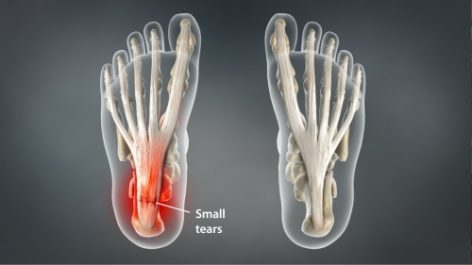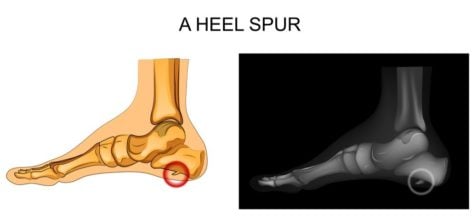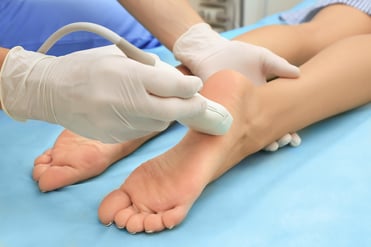What could be my problem?

Plantar Fasciitis
Plantar Fasciitis pain develops when the plantar fascia ligament of your foot (the band of tissue that extends from your heel to your toes) becomes inflamed and painful. Excessive stretching of your plantar fascia over time causes micro tearing of the ligament resulting in foot arch pain. Continued pressure on your arch due to inadequate arch support will also cause the ligament to pull at the insertion point on the bottom of the calcaneous bone, resulting in heel pain.
Scroll Down To See Treatment Options

Heel Spur
A calcium deposit causing a bony protrusion on the underside of the heel bone. On an x-ray, a heel spur can extend forward by as much as a half-inch. Without visible x-ray evidence, the condition is sometimes known as “heel spur syndrome”.
Heel spur pain is always associated with untreated plantar fasciitis. This is due to the plantar fascia ligament pulling excessively on the heel spur secondary to inadequate arch support.
What causes Plantar Fasciitis?
- Faulty structure of the foot
- High-arched feet
- Flat feet
- Wearing non-supportive footwear on hard, flat surfaces putting abnormal strain on the plantar fascia
- Long hours on the feet
- Obesity
- Overuse
When should I see a foot doctor about plantar fasciitis?
- Pain on the bottom of the foot
- Pain in the arch of the foot
- Foot arch or heel pain that is worse upon getting up from rest, but diminishes after a few minutes of walking
- Pain that increases over a period of months
- Swelling on the bottom of the heel
- Pain that subsides, but then returns after spending long periods of time on your feet
What are my treatment options for plantar fasciitis?
Non-Surgical Treatment Options:
- Diagnostic Imaging to confirm clinical findings
- Cold therapy

- Physical therapy
- Limit activities
- Shoe modifications
- Custom orthotics
- Padding, tapping and strapping
- Ultrasound Guided Corticosteroid injection therapy
- Removable walking cast
- Night splint
- Proper footwear
Surgical Treatment Options:
If after several months of non-surgical treatment, you continue to have arch and heel pain from plantar fasciitis surgery may be an option. Plantar fascia release surgery involves cutting part of the plantar fascia ligament to release tension to relieve the inflammation of the plantar fascia ligament.
Surgical options are followed by immobilization (hard or soft casting, limited weight bearing) and physical therapy. Personalized pain medication therapy will be prescribed as needed.
Heel Spur
What causes a Heel Spur?
- Walking gait abnormalities which place excessive stress on the heel bone, ligaments and nerves near the heel
- Running or jogging, especially on hard surfaces
- Poorly fitted or badly worn shoes without proper arch support
- Excess weight and obesity
- Increasing age which decreases plantar fascia flexibility and thins the heel’s protective fat pad
- Diabetes
- Spending most of the day on one’s feet
- Frequent bursts of physical activity
- Flat feet or high arches
When should I see a foot doctor about my Heel Spur?
- If you have heel pain that lasts for more than one month
- Swelling on the bottom of the heel
- Foot arch or heel pain that is worse on getting up from rest, but diminishes after a few minutes of walking
- Pain on the bottom of the foot
- Pain in the arch of the foot
- Pain that increases over a period of months
- Pain that subsides, but then returns after spending long periods of time on your feet
What are my treatment options?
Non-Surgical Treatment Option
Surgical Treatment Options
If conservative, non-surgical treatment fail to relieve symptoms of your heel spur, then a surgical treatment may be recommended by your podiatrist to relieve the pain and restore your foots mobility. Surgical treatment option include:
- Release of the plantar fascia (see above under Plantar Fasciitis surgical treatment)
- Removal of the heel spur - minimally invasive surgery is available
- Both of the above
Make An Appointment



